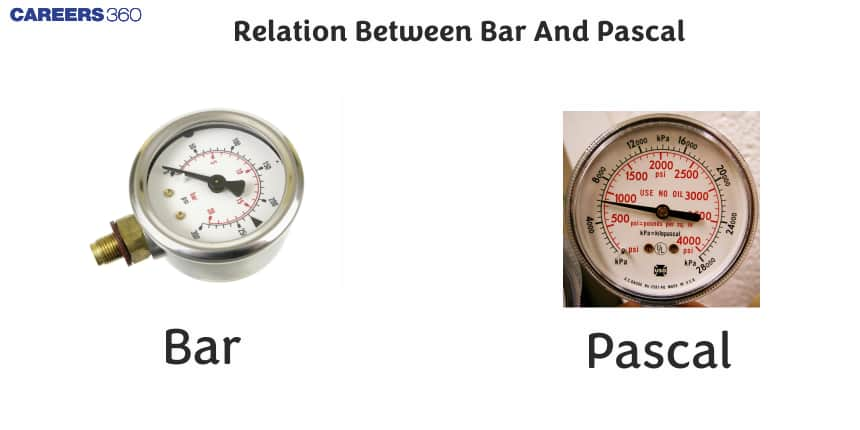Relation Between Bar And Pascal - A Complete Guide
In this article, we will learn about the concepts of bar and pascal, their uses, how to convert bar into pascal. Bar and Pascal are important terms in pressure measurement in physics and engineering. Though Pascal is the SI unit, the bar is usually preferred in practical applications owing to the larger magnitude of its measure. This article will take you through a complete overview of both units relative to each other, and how to convert between them.

What is Pascal?
The Pascal is the S.I. unit of pressure, and it is also used to calculate internal pressure, stress, Young's modulus, and ultimate tensile stress. Blaise Pascal inspired the unit's name. As a unit of pressure measurement, the Pascal ( Pa ) or kilopascal ( kPa ) is extensively used around the world.
$
1 \mathrm{~Pa}=1 \frac{\mathrm{~N}}{\mathrm{~m}^2}=1 \frac{\mathrm{~kg}}{\mathrm{~m} \cdot \mathrm{~s}^2}=1 \frac{\mathrm{~J}}{\mathrm{~m}^3}
$
Also, read
What is a Bar?
Bar is a unit of pressure metric, excluded in the S.I. unit, but exactly equivalent to 100,000 Pa or just under the average atmospheric pressure at sea level on Earth (1.013 bar). The bar and millibar were introduced by the Norwegian meteorologist Vilhelm Bjerknes, who was known for pioneering the field of weather forecasting. Derived from the bar, megabar (Mbar), kilobar (kbar), decibar (dbar), centibar (cbar), and millibar (mbar).
$
1 \mathrm{bar}=10^5 \mathrm{~Pa}=10^5 \frac{\mathrm{~N}}{\mathrm{~m}^2}=10^5 \frac{\mathrm{~kg}}{\mathrm{~m} \cdot \mathrm{~s}^2}
$
What is the Relationship Between a Bar And a Pascal?
| Bar to Pascal formula |
1 bar $=10^5$ pascals |
| Pascal to bar formula |
1 pascal $=10^{-5}$ bar |
Conversion of Bar and Pascal
| Units | Values |
| 1 bar to kilopascal |
$1 \mathrm{bar}=100 \mathrm{kPa}$ |
| 1 bar to mPa |
$1 \mathrm{bar}=0.1 \mathrm{mPa}$ |
| mbar to pascal |
$1 \mathrm{mbar}=100 \mathrm{~Pa}$ |
| 1 bar to atm |
$1 \mathrm{bar}=0.986923 \mathrm{~atm}$ |
Uses of Pascal (Pa)
Pascal (Pa) is the SI unit of pressure.
It is used when we need accurate and small measurements of pressure.
- Used in physics and science experiments to measure pressure accurately.
- Used in fluid mechanics to calculate pressure in liquids and gases.
- Helps in studying pressure difference in pipes and closed containers.
- Used in meteorology (weather science) to express atmospheric pressure in Pa, kPa, or hPa.
- Used to measure stress and pressure on surfaces in engineering and construction.
Uses of Bar
Bar is a practical (non-SI) unit of pressure.
It is used for larger pressures, where Pascal becomes too small.
- Used to measure air pressure in weather forecasting (often in millibar).
- Used for tyre pressure in cars, bikes, and aircraft.
- Commonly used in diving to measure pressure underwater.
- Used in industrial machines like compressors and pressure gauges.
- Found in refrigeration and AC systems to measure gas pressure.
- Used in oil and gas industries to measure pressure in pipes and tanks.
Frequently Asked Questions (FAQs)
The unit of pressure is pascal which is denoted by Pa.
(i) Pa to bar
1 Pa = 10-⁵ bar
(ii) Atm to Pa
1 atm = 1.013 ✕ 10⁵Pa
(iii) Bar to kpa
1 bar = 100kpa
(iv) Bar to Mpa
1 bar = 0.1 Mpa
(v) Bar to Pa
1 bar = 10⁵Pa
1 pascal is equal to one newton/per meter square.
1 Pa = 1n/m²
Bar is the metric unit of pressure.
1 bar = 10⁵Pa
1 bar to millibar
1 bar = 1000mbar
(i) 1 kg /cm2 to bar
1 kg/cm2 = 0.980665 bar
(ii) 1 pascal to torr
1 pascal = 0.00750062 torr
(iii) convert 0.1 mpa to bar
0.1 mpa = 10-⁹bar
(iv) bar to megapascal
1 bar = 0.1 Mpa
(v) 10 bar to kpa
10 bar = 1000kpa.